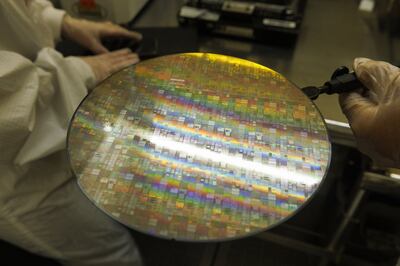Global semiconductor revenue is projected to grow at a slower than expected pace this year, with the crunch in the industry extending well beyond 2022, a study by Gartner has found.
The chip market will reap about $639 billion in revenue this year, clocking a 7.4 per cent growth, almost half the growth rate the US research company forecast in May, when the revenue expectation was $676bn.
It is also a considerable slowdown from the 26.3 per cent surge the sector recorded in 2021 when revenue hit about $595bn, Gartner said.
“Although chip shortages are abating, the global semiconductor market is entering a period of weakness," said Richard Gordon, vice president at Gartner. He added that the downward trend will persist through 2023, with revenue set to decline 2.5 per cent.
“The semiconductor market is entering an industry down cycle, which is not new, and has happened many times before ... rising inflation, taxes and interest rates, together with higher energy and fuel costs, are putting pressure on consumer disposable income. This is affecting spending on electronic products such as PCs and smartphones,” Mr Gordon said.
Semiconductor manufacturers were faced — and continue to do so — with unprecedented demand for chips owing to the effects of the Covid-19 pandemic, which propelled sales most notably for consumer electronics as people were forced to stay at home.
The global health crisis hugely disrupted semiconductor shipments as global demand skyrocketed, causing a supply chain breakdown.
While restrictions stemming from the pandemic have largely been removed, people were able to discover the convenience of remote activity, which has influenced work, study and others, resulting in continued demand for chip-powered devices.
Gartner's forecast is in line with other projections for a record year for the industry. Allianz unit Euler Hermes said earlier this year that sales in the global semiconductor industry will cross the $600bn mark for the first time in 2022, while World Semiconductor Trade Statistics said in its latest projections that revenue will hit $646bn this year.
Intel, however, expects the global chip crunch to continue until 2024 due to the constrained availability of key manufacturing tools, serving as an obstacle to expanding capacity levels required to meet elevated demand.
The growing demand across industries, complemented by growing internet penetration triggered by the pandemic as more people work remotely, will only increase demand and cement the fact that a global shortage of semiconductors could take more time to be resolved, Taha Khalifa, Intel's client computing group sales director for Europe, the Middle East and Africa, told The National in an interview.

"The semiconductor industry is continuing to play catch-up from the devastating effects of Covid-19 and the booming demand for chips. Companies have been placing inflated orders to ensure increased stock, which also puts additional pressure on manufacturers," he said.
Mr Khalifa said semiconductors are the underlying technology powering the "digitalisation of everything".
This is being accelerated by what Intel chief executive Pat Gelsinger calls the "four superpowers" in the industry — ubiquitous computing, pervasive connectivity, cloud-to-edge infrastructure and artificial intelligence.
These technologies are growing in scope, fundamentally altering how people experience technology and interact with devices, from PCs to other connected devices, including smart homes and cars, Mr Khalifa said.
"If we look at the growing demand across industries, complemented by growing internet penetration triggered by the pandemic as more people work remotely, the demand will only increase, cementing the fact that a global shortage of semiconductors could take more time to be resolved," he added.
Gartner, meanwhile, said semiconductor revenue from PCs is estimated to post a decline of 5.4 per cent in 2022, as shipments are set to decrease by 13.1 per cent, after recording growth in 2020 and 2021.
Revenue from smartphones — the most popular consumer electronic product — is also likely to slow down to 3.1 per cent this year, compared to a 24.5 per cent surge in 2021.
The weakness in the consumer space will be compensated by the strength in the data centre market, which, he said, will grow 20 per cent in 2022 and remain resilient for longer as investments in cloud infrastructure pick up pace.
The vehicle electronics segment, on the other hand, will continue to record double-digit growth over the next three years as semiconductor content per vehicle will increase due to the transition to electric and autonomous vehicles.
"Companies have been placing inflated orders to ensure increased stock which also puts additional pressure on manufacturers," Mr Khalifa said, adding that measures have been put in place to try to stop over-ordering, "but it is only a temporary fix for a larger problem".
California-based Intel, one of the world's biggest technology companies, is scheduled to report its second-quarter results on Thursday.







